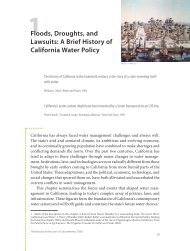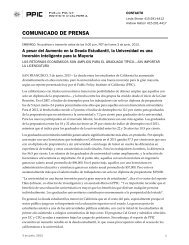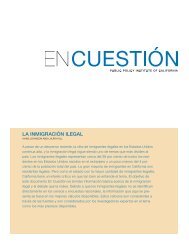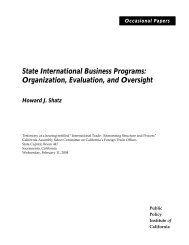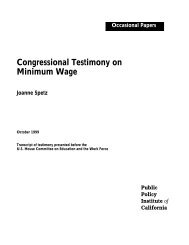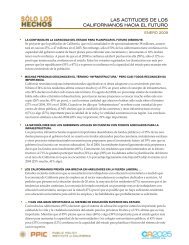Transportation Spending by Low-Income California Households ...
Transportation Spending by Low-Income California Households ...
Transportation Spending by Low-Income California Households ...
Create successful ePaper yourself
Turn your PDF publications into a flip-book with our unique Google optimized e-Paper software.
difficulty with crowding or getting a seat, cost of travel <strong>by</strong> public transit,<br />
time of day availability when they need to use it, transit stations and<br />
vehicles not being clean, and time and aggravation with transfers.” 14<br />
Although these NPTS results are for the general public and therefore<br />
may not be applicable to low-income households, surveys of welfare<br />
recipients in Fresno and in Los Angeles arrive at similar results. 15<br />
Surveys of the low-income population in the Bay Area to determine<br />
which facets of transportation service affect them most (including price)<br />
would be helpful for understanding the implications of the tradeoffs that<br />
must be made when transportation funding is limited.<br />
Flexible Pricing<br />
Creating transit pricing schemes that vary with distance and time of<br />
day would align fares more closely with the actual cost of the trip and<br />
shift the burden of fares away from low-income riders. (Higher-income<br />
riders are more likely to take longer trips and ride during peak hours.)<br />
Taylor (1998) notes that “[L]ower-income riders disproportionately<br />
consume off-peak, relatively inexpensive-to-provide services, while<br />
higher-income riders are more likely to consume expensive peak service.<br />
The net effect is a regressive cross-subsidy from low-income to highincome<br />
riders. Transit-dependents pay more per-mile and per-hour for<br />
the transit service they consume, while per-rider subsidies tend to<br />
increase with ability to pay” (p. 33). Linking fares to distance and time<br />
of day would mean that riders who receive more in services (i.e., traveling<br />
longer distances) and riders who impose higher costs on the transit<br />
system (<strong>by</strong> contributing to congestion during peak hours and decreasing<br />
seat turnover on long trips) would pay more. BART currently has<br />
distance-based pricing, as do several of the bus systems. The<br />
TransLink® fare payment system may make it easier to provide distancebased<br />
fares on buses, particularly if a global positioning system (GPS) is<br />
installed. 16 None of the transit agencies in the Bay Area are known to<br />
_____________<br />
14 Polzin, Rey, and Chu (1998), p. 5-3.<br />
15 Moreno et al. (2000), p. vi., and Blumenberg and Haas (2001), p. 46.<br />
16 Golden Gate Transit already has GPS installed on its buses.<br />
111



